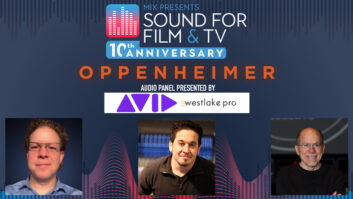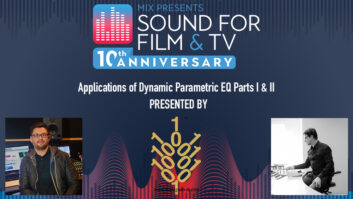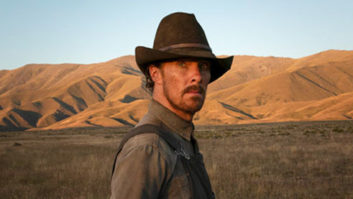On the traditional soundstage, wired boom mics largely defined the limits and possibilities for film and television production. Over the past 30 years, sound engineer Edward Tise has pioneered advances in wireless audio to expand the possible. Now, equipped with the Sony DWX Series digital wireless microphone system, he wields a creative palette that alters the look and feel of what we see and hear on screen.
“Wireless mics have become a crucial technology to enable the evolution in how directors work,” said Tise. “In the ’60s and ’70s, you had single-camera wide establishing shots where you never heard what actors said. Now we have multiple cameras shooting establishing shots and close-ups at the same time. We’re also working in smaller spaces where it’s hard to get into a good position [with a boom mic] between lenses and lighting. You need no-compromise wireless to make this happen.”

Tise began his career working on documentaries. He made a turn into dramatic films after being recruited by director Stanley Kubrick for his landmark Full Metal Jacket. His documentary sensibilities proved right for capturing the gritty realism portrayed from boot camp to combat. The shoot, like so many of Kubrick’s classics, required innovation to achieve the director’s singular vision. Kubrick insisted that Tise not use any boom mics because he saw them as a distraction to actors and a hindrance to his ability to pan up on a scene. The solution? Wireless body packs. Kubrick was not confident in the technology, then in its infancy. Tise made it work.
“Full Metal Jacket marks a turning point because we had to go past the limits of wired mics to get where we needed to be. Wireless then had real limits that we had to work around. Still, this was obviously the way of the future,” said Tise.
Jennifer Lopez: Getting the Lo Down, by Clive Young, Oct. 30, 2014
The result speaks for itself. The film, a paragon of filmmaking, is accentuated by the realism of the audio. Kubrick did make one concession to wired technology, immortalizing Tise’s role on the production. The only boom mic that made it into Full Metal Jacket is on camera. In a memorable scene, Tise has a bit part running audio in a film crew interviewing soldiers.
Wired into Wireless Advances
After that noteworthy start, Tise continued to refine and advance his technique in dozens of well-known productions, including Kubrick’s final film, Eyes Wide Shut. His signature detail-rich sound has helped define dozens of features including Three Kings and Love & Mercy, as well as TV work including Fear the Walking Dead. Along the way, his portfolio reflects the enormous advances of wireless audio culminating in Sony’s DWX Series.

According to Tise, as Sony’s digital wireless transmission began to replace earlier analog technology, productions could stop shortchanging quality for convenience on the set.
To appreciate the significance, Tise continued, you have to understand the issues analog technology introduced: “I’d plug an excellent boom mic into a wireless system using a compander and get the unwanted distractions of a stressed wireless component. Bright, percussive sounds like keys, coins and sibilance tracked poorly, with unnatural results. Dynamic swings introduced noise at low levels and crushed peaks, flattening performance. The introduction of the Sony digital DWT-P01 plug-on transmitter with DWR receiver marked a fundamental advance that finally brought wireless sound quality to where it is indistinguishable from wired,” said Tise.
Sony Adds to Charlie Daniels’ Volunteer Jam, Oct. 12, 2015
Now, with Sony’s true digital wireless, the boom mic is able to play a proper role balancing wireless body packs to capture a complete sonic environment full of detail and depth with ease. Add to that a host of added functionality and features built into the DWX series, according to Tise.

“The operating system gives an incredible amount of control. Remote control of transmitter functions from the DWR receiver seemed like a luxury feature at first, but soon I couldn’t do without it. After the shortest trial run with the equipment, I bought the first units that came onto the market,” Tise said.
Since, Tise’s DWX-series setup consists of five DWR-S02D portable receivers, four DWA-01D/DWA-F01D adapters, five DWT-B01 body pack transmitters and six DWT-P01 plug-on transmitters, two in each of the three frequency banks. The system’s capabilities are immediately apparent in their ability to render otherwise difficult dialogue intelligible.
“Using the body packs on key actors pulls detail out of the soup that I’ve never heard before. You really see this with low level performances, when dialogue gets quieter, dropping into whispers. The intimacy of the performances comes through, and this cuts the need for looping lost lines that is a constant issue with boom mics,” Tise said.
But dialogue is just one element on set. Being able to catch the right tone and texture was essential for his work on Love & Mercy, the Brian Wilson Beach Boys bio pic. Variety magazine’s film review singled out Tise as the “real hero of the below-the-line crew” for creating a visceral experience with rich elements including “elaborate mosaics of sounds of silverware on porcelain.”

“My signature is capturing detail, communicating the feel of the on-screen experience. The Sony wireless system close-in picked up all this depth in Love & Mercy. Plucked strings, tapping on a drum kit—the radio mic captured it like it was Foley [recorded effects],” Tise said.
While audio quality is of primary importance, the Sony system’s wide-ranging utility has also brought Tise many welcome surprises. “I’m always concerned about range. Sometimes, you’re lucky to get 50 feet, but I discovered what the DWX can do almost by accident on Fear the Walking Dead. I set the transmitters to 10 mW for a scene with two actors in a car with the camera mounted on the hood. They took off, driving some 400 yards off and it still worked! Since, I’ve gone a full quarter-mile at 50 mW,” he said.
Want more stories like this? Subscribe to our newsletter and get it delivered right to your inbox.
As important is the bandwidth and frequency separation. The DWX-series tripled the bandwidth, allowing Tise to trim his production kit, a great benefit for location shooting abroad.
“The wide spectrum and close channel spacing makes efficient use of our shrinking RF world. Sony’s three different spectrum blocks [up to 72 Mhz each], and the fact that true Digital Wireless transmission has almost no IM [inter-modulation distortion, allowing for even spacing of channels], lets me have plenty of spectrum for many more compatible channels when using multiple systems simultaneously. I can also tune them in 25 KHz increments if needed for integration in mixed systems. With the previous technology, I had to carry massive amounts of gear to have enough channels and separation to get past frequency issues.”
A Title Earned, a profile of Edward Tise by Glen Trew of Trew Audio
While the Sony wireless system defines the current state-of-the-art, is there anything left on Tise’s wish list for wireless?
“The DWX really is just about perfect. I only wish Stanley Kubrick was still with us to see what we could do with it.”
A version of this story appeared in issue 8 of Sony Professional’s Action Magazine.
Sony DWX Series • pro.sony/en_CA/products/dwx-digital-wireless-series







